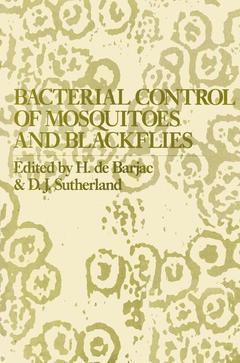Description
Bacterial Control of Mosquitoes & Black Flies, 1990
Biochemistry, Genetics & Applications of Bacillus thuringiensis israelensis and Bacillus sphaericus
Coordinators: de Barjac Huguette, Sutherland Donald J.
Language: English
Subjects for Bacterial Control of Mosquitoes & Black Flies:
Keywords
Mammalia; bacteria; classification; climate; development; genetics; insecticide; insects; pesticide; pesticides; predator; resistance; system
Publication date: 03-2012
349 p. · 15.5x23.5 cm · Paperback
349 p. · 15.5x23.5 cm · Paperback
Description
/li>Contents
/li>
Mosquitoes and black flies are a constant threat to health and comfort, yet the modern chemical pesticides used to control them have cre ated serious ecological problems. Populations of resistant mosquitoes and black flies have evolved, beneficial insects and natural predators have been destroyed, and environmental pollution has increased worldwide. Therefore, scientists have energetically sought new, environmentally safe technologies to combat mosquitoes and black flies and the diseases they carry. Among the most effective alternative means of controlling these pests are the highly spe cific microbial agents derived from Bacillus tburingiensis or Bacillus spbaericus. The microbial control of mosquitoes and black flies is a very important, rapidly developing area of science. Entomologists and microbiologists have already achieved spectacular successes using B. tburingiensis and B. spbaericus against these pests. Recent discoveries of new bacterial isolates specific to new hosts and recent genetic improvements in these isolates have created the potential for wide-scale use of these biological control agents. Efficient microbial control of mosquitoes and black flies can now be achieved, but a proper knowledge of factors relating to the safe and effective use of these biological control agents is necessary. The efficacy of B. tburingiensis and B. spbaericus is influenced by the inherent differential tol erance of the target mosquitoes or black flies, by the formulation technology and application of these agents, and by environmental factors, especially sun light and temperature.
1 Bacillus thuringiensis subsp. israelensis (B.t.i.).- 1 Discovery of Bacillus thuringiensis israelensis.- 2 Characterization and Prospective View of Bacillus thuringiensis israelensis.- 3 Parasporal Body of Bacillus thuringiensis israelensis: Structure, Protein Composition, and Toxicity.- 4 Mechanism of Action of Bacillus thuringiensis israelensis Parasporal Body.- 5 Genetics of Bacillus thuringiensis israelensis.- 6 Cloning of Bacillus thuringiensis israelensis Mosquito Toxin Genes.- 7 Transfer of the Bacillus thuringiensis israelensis Mosquiticidal Toxin Gene into Mosquito Larval Food Sources.- 8 Potential for Improved Formulations of Bacillus thuringiensis israelensis through Standardization and Fermentation Development.- 9 Activity, Field Efficacy, and Use of Bacillus thuringiensis israelensis against Mosquitoes.- 10 Progress in the Biological Control of Black Flies with Bacillus thuringiensis israelensis, with Emphasis on Temperate Climates.- 11 Use of Bacillus thuringiensis israelensis for Onchocerciasis Control in West Africa.- 12 Mammalian Safety of Bacillus thuringiensis israelensis.- 2 Bacillus sphaericus.- 3 Introduction to the Study of Bacillus sphaericus as a Mosquito Control Agent.- 14 Classification of Bacillus sphaericus Strains and Comparative Toxicity to Mosquito Larvae.- 15 The Mosquito Larval Toxin of Bacillus sphaericus.- 16 Genetics of Bacillus sphaericus.- 17 Local Production of Bacillus sphaericus.- 18 Persistence and Formulation of Bacillus sphaericus.- 19 Formulations and Persistence of Bacillus sphaericus in Culex quinquefasciatus Larval Sites in Tropical Africa.- 20 Field Trials of Bacillus sphaericus for Mosquito Control.- 21 Mammalian Safety of Bacillus sphaericus.- 3 The Future.- 22 The Future of Bacterial Control of Mosquito and Black Fly Larvae.
© 2024 LAVOISIER S.A.S.
These books may interest you

Fruit FliesBiology and Management 158.24 €



